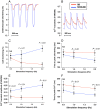Human cardiomyocyte calcium handling and transverse tubules in mid-stage of post-myocardial-infarction heart failure
- PMID: 29431258
- PMCID: PMC5933953
- DOI: 10.1002/ehf2.12271
Human cardiomyocyte calcium handling and transverse tubules in mid-stage of post-myocardial-infarction heart failure
Abstract
Aims: Cellular processes in the heart rely mainly on studies from experimental animal models or explanted hearts from patients with terminal end-stage heart failure (HF). To address this limitation, we provide data on excitation contraction coupling, cardiomyocyte contraction and relaxation, and Ca2+ handling in post-myocardial-infarction (MI) patients at mid-stage of HF.
Methods and results: Nine MI patients and eight control patients without MI (non-MI) were included. Biopsies were taken from the left ventricular myocardium and processed for further measurements with epifluorescence and confocal microscopy. Cardiomyocyte function was progressively impaired in MI cardiomyocytes compared with non-MI cardiomyocytes when increasing electrical stimulation towards frequencies that simulate heart rates during physical activity (2 Hz); at 3 Hz, we observed almost total breakdown of function in MI. Concurrently, we observed impaired Ca2+ handling with more spontaneous Ca2+ release events, increased diastolic Ca2+ , lower Ca2+ amplitude, and prolonged time to diastolic Ca2+ removal in MI (P < 0.01). Significantly reduced transverse-tubule density (-35%, P < 0.01) and sarcoplasmic reticulum Ca2+ adenosine triphosphatase 2a (SERCA2a) function (-26%, P < 0.01) in MI cardiomyocytes may explain the findings. Reduced protein phosphorylation of phospholamban (PLB) serine-16 and threonine-17 in MI provides further mechanisms to the reduced function.
Conclusions: Depressed cardiomyocyte contraction and relaxation were associated with impaired intracellular Ca2+ handling due to impaired SERCA2a activity caused by a combination of alteration in the PLB/SERCA2a ratio and chronic dephosphorylation of PLB as well as loss of transverse tubules, which disrupts normal intracellular Ca2+ homeostasis and handling. This is the first study that presents these mechanisms from viable and intact cardiomyocytes isolated from the left ventricle of human hearts at mid-stage of post-MI HF.
Keywords: Calcium handling; Cardiomyocytes; Excitation contraction coupling; Heart failure; Myocardial infarction; SERCA2a.
© 2018 The Authors. ESC Heart Failure published by John Wiley & Sons Ltd on behalf of the European Society of Cardiology.
Figures






References
-
- Heinzel FR, Bito V, Biesmans L, Wu M, Detre E, von Wegner F, Claus P, Dymarkowski S, Maes F, Bogaert J, Rademakers F, D'Hooge J, Sipido K. Remodeling of T‐tubules and reduced synchrony of Ca2+ release in myocytes from chronically ischemic myocardium. Circ Res 2008; 102: 338–346. - PubMed
-
- Bers DM. Altered cardiac myocyte Ca regulation in heart failure. Physiology (Bethesda) 2006; 21: 380–387. - PubMed
-
- Schillinger W, Lehnart SE, Prestle J, Preuss M, Pieske B, Maier LS, Meyer M, Just H, Hasenfuss G. Influence of SR Ca(2+)‐ATPase and Na(+)‐Ca(2+)‐exchanger on the force–frequency relation. Basic Res Cardiol 1998; 93: 38–45. - PubMed
Publication types
MeSH terms
Substances
Grants and funding
LinkOut - more resources
Full Text Sources
Other Literature Sources
Medical
Molecular Biology Databases
Research Materials
Miscellaneous

